Abstract
Fractional differential equations depict nature sufficiently in light of the symmetry properties which describe biological and physical processes. This article is concerned with the numerical treatment of three-term time fractional-order multi-dimensional diffusion equations by using an efficient local meshless method. The space derivative of the models is discretized by the proposed meshless procedure based on the multiquadric radial basis function though the time-fractional part is discretized by Liouville–Caputo fractional derivative. The numerical results are obtained for one-, two- and three-dimensional cases on rectangular and non-rectangular computational domains which verify the validity, efficiency and accuracy of the method.
1. Introduction
Over the most recent couple of decades, fractional-order differential equations have been effectively utilized for modeling a wide range of processes and systems in the applied sciences and engineering. The basic information on fractional calculus can be found in [1,2,3]. The extensive applications in science and engineering are portrayed by fractional partial differential equation (PDEs) [4,5,6,7,8]. It is observed that the multi-term time-fractional PDEs are suggested to improve the modelling accuracy in depicting the anomalous diffusion process, modeling different sorts of viscoelastic damping, precisely catching power-law frequency dependence and simulating flow of a fractional Maxwell fluid [9].
In the present time, the researchers worked developing methods for the approximate and exact solutions for fractional PDEs. In this regard, numerous methods have been employed for the solution like finite difference method [10], homotopy analysis method [11,12], meshless method [13,14,15,16], Riccati transformation approach [17], Adomian decomposition method [18], expansion methods [19,20] and variational iteration algorithms [21,22].
Meshless methods have been got more attention for handling different sort of PDE models arise in various fields of science and technology. Particularly the meshless method based on radial basis functions (RBFs) are one of the most well-known sorts among these techniques. Unlike the traditional methods of finite difference and finite element, the meshless techniques do not need mesh in computational domains and can be applied efficiently to multi-dimensional PDE models with complex domains [23]. As per these realities, meshless strategies are known to be truly adaptable and valuable and are broadly utilized to numerous useful problems [24]. Despite the fact that the standard global meshless collocation strategy depends on the globally supported RBFs is known to be a proficient computational procedure. In this procedure the RBFs are used to obtain the coefficients, so that the derivatives of a function can be written as a linear combination of the functional values at the predetermined nodes, but the technique leads to an ill-conditioned and dense system of algebraic equations due to shape parameters sensitivity and a large number of collocation points. Tragically, the computational cost of execution and ill-conditioning of the procedure will increment drastically by increasing the number of collocation points. To avoid these limitations, the researchers recommended local meshless techniques [25,26]. The beauty of the local meshless technique is utilizing just neighbouring collocation points which results in a sparse matrix system and ward off the main deficiency of ill-conditioning. This sparse system of equations can effectively be solved [27,28,29].
According to [30], Symmetry is a fundamental property of nature and its phenomena. Therefore, the fractional-order diffusion equations are able to adequately describe physical and biological processes and have symmetry properties, which follow from some fundamental laws. The current work is dedicated to utilize the local meshless method (LMM) for the numerical investigation of three-term time fractional-order diffusion model equations up to three space dimensions. The space derivatives of the model equations are calculated by the proposed local meshless algorithm utilizing multiquadric (MQ) radial basis functions (RBFs) while time-fractional part is approximated by using Liouville–Caputo definition. The suggested algorithm is tested on non-rectangular domains as well in two- and three-dimensional case in numerical examinations. Consider the unsteady three-term time-fractional diffusion PDE
where the initial and boundary conditions are as follows
where is the diffusion coefficient and for one-dimensional (1D) case , for two-dimensional (2D) case and for three-dimensional (3D) case .
2. Proposed Methodology
The LMM [26,31] is utilized for the solution of time-fractional convection-diffusion models. The derivatives of at the centers are approximated by the neighborhood of , , where . The local meshless procedure for 1D case is as follows
Substituting RBF in Equation (3)
where in case of MQ RBF.
Matrix form of Equation (4) can be written as
From Equation (5), we obtain
The derivatives of in term of x and y are calculated for 2D case by utilizing the above procedure as follows
To find coefficients and ( ), we continue as
The above technique can be rehashed for the three-dimensional case.
2.1. Time Discretization
The derivative in time direction for is calculated by by means of the Liouville–Caputo derivative definition [32]
Consider equally spaced time intervals , in , such that , , where time step size is denoted by to calculate the time-fractional derivative th time level is
The term is approximated as follows
with truncation error (see [33])
Letting and , , the above equation can be written as follows
A similar methodology is employed for fractional derivative of order and .
2.2. A -Weighted Technique
3. Numerical Results and Discussions
This section is concerned with the numerical results of the one-, two- and three-dimensional three-term time-fraction diffusion model equations utilizing the suggested efficient local meshless method (LMM). The implicit time discretization scheme is coupled with the LMM based on multiquadric radial basis function with shape parameter in all numerical simulation. Every single numerical trial are performed utilizing local supported domain , and in one-, two- and three-dimensional case respectively, additionally the source functions in each case can be computed easily in the accordance of the corresponding exact solution. The accuracy is measure through different error norms which are defined as follows
where , U and denote the exact solutions, approximate solution and space step size respectively.
3.1. Test Problem
Initial and boundary conditions can found in accordance to the exact solution.
The simulation results for Test Problem in Section 3.1 are calculated utilizing the suggested LMM and Tabulated in Table 1 using various values of time-step size and nodal points N. It can be revealed from Table 1 that the accuracy increments to some extent with the increase in N and decrease in . Figure 1 (left) shows the results of different time t versus for whereas Figure 1 (right) shows the results at different nodal points N versus for . This figure is the evidence of good accuracy of the suggested LMM. The visual representation in form of absolute error for up to is given in Figure 2. Figure 3 represents the comparison of the proposed LMM and the method given in [35], and we can see for this figure that the LMM method produced better results.

Table 1.
Numerical results using , , and for Test Problem Section 3.1.
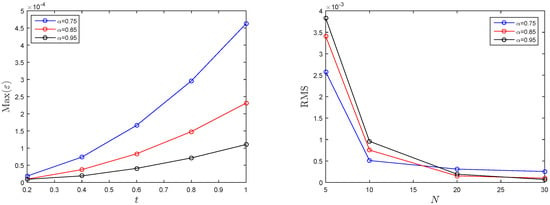
Figure 1.
Simulation results using (left), (right) and , , for Test Problem in Section 3.1.

Figure 2.
Simulation results using , , , and (left), (right) for Test Problem in Section 3.1.
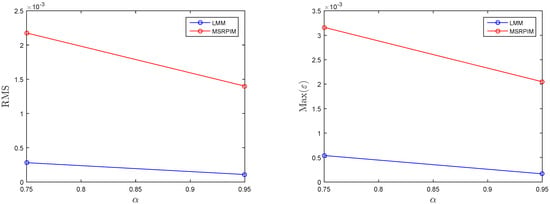
Figure 3.
Simulation results of the LMM and the MSRPIM [35] using , , , and for Test Problem in Section 3.1.
3.2. Test Problem
Consider the Equation (1) as 2D three-term diffusion equation with , having exact solution [35] is given as
The simulation results for Test Problem in Section 3.2 are calculated in terms of absolute error, and norms, are visualized in Figure 4, Figure 5, Figure 6, Figure 7 and Figure 8 using the suggested LMM. In Figure 4 and Figure 5, we have compared the numerical results, in term of and error norms, of the suggested LMM and the method given in [35]. It can be seen that in this test problem the LMM gives accurate results when contrasted with the technique in [35]. Figure 6 shows the exact, numerical and absolute error for Test Problem in Section 3.2 which is the evidence of the proposed method for better accuracy. The LMM is tested on non-rectangular domains as shown in Figure 7 and Figure 8. It is obvious from these figures that the LMM gives great numerical results irrespective of the domains.
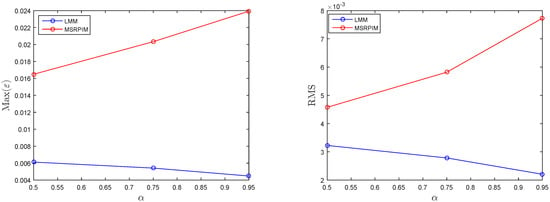
Figure 4.
Simulation results of the LMM and the MSRPIM [35] using , , , , and for Test Problem in Section 3.2.
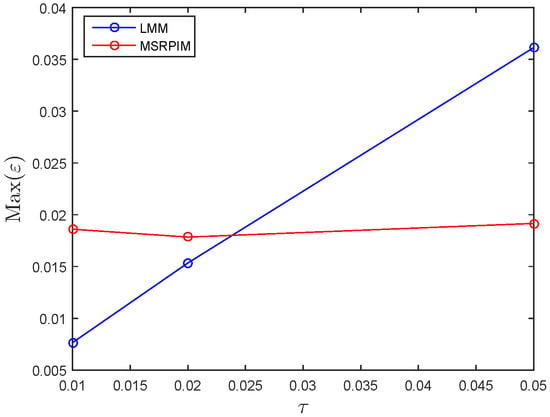
Figure 5.
Simulation results of the LMM and the MSRPIM [35] using , , , , and for Test Problem in Section 3.2.

Figure 6.
Simulation results using , , , , and for Test Problem in Section 3.2.
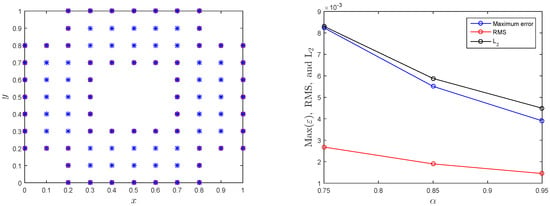
Figure 7.
Computational domain (left) and numerical results in term of different errors norms (right) using , , , and for Test Problem in Section 3.2.
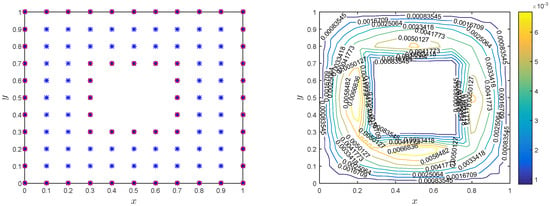
Figure 8.
Computational domain (left) and (right) using , , , , and for Test Problem in Section 3.2.
3.3. Test Problem
Consider the 3D three-term fractional-order diffusion Equation (1). For the exact solutions is
The simulation results for Test Problem in Section 3.3 are appeared in Figure 9 for various fractional-order and N. It tends to be see from the figure that the accuracy increments with increment in nodal points N to some extent. To testify the performance of the LMM on non-rectangular domains in three-dimensional case, the results are shown in Figure 10 and Figure 11.
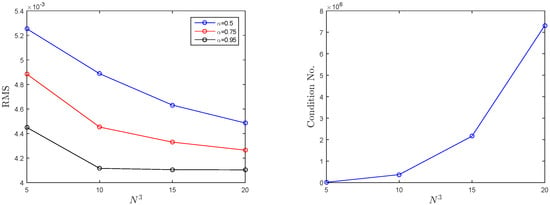
Figure 9.
Simulation results using , , and (left) and condition number (right) for Test Problem in Section 3.3.
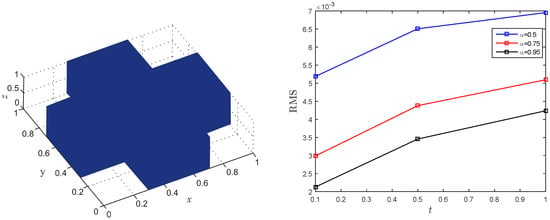
Figure 10.
Computational domain (left) and absolute error (right) using , , and for Test Problem in Section 3.3.
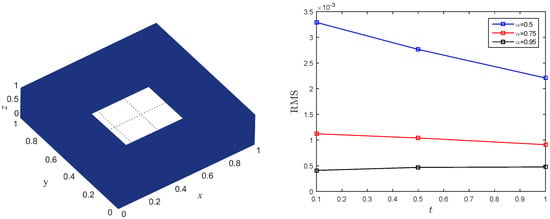
Figure 11.
Computational domain (left) and absolute error (right) using , , and for Test Problem in Section 3.3.
4. Conclusions
The current research is concerned with an efficient computational algorithm, named local meshless method, utilizing radial basis functions to approximate three-term time fractional-order diffusion PDE models in one-, two- and three-dimensions. The Liouville–Caputo definition is utilized in order to compute the time derivative the algorithm is constructed for . To test the accuracy of the suggested LMM both rectangular and non-rectangular domains are considered in the test problems. The simulation results are evidence that the suggested LMM is a flexible interpolation method. In light of the current work, we can say that the proposed technique is powerful and effective to approximate the solution of multi-term time-fractional PDEs, so it can be also applied to a wide range of complex problems that occur in natural sciences and engineering.
Author Contributions
Conceptualization, I.A. and H.A.; methodology, I.A.; software, I.A. and P.T.; validation, I.A., H.A. and P.T.; formal analysis, C.C. and P.T.; investigation, Y.-M.C., H.A. and C.C.; resources, Y.-M.C.; data curation, I.A.; writing—original draft preparation, I.A. and H.A.; writing—review and editing, C.C., P.T. and Y.-M.C.; visualization, I.A.; supervision, I.A., C.C. and H.A.; project administration, C.C; funding acquisition, Y.-M.C. All authors have read and agreed to the published version of the manuscript.
Funding
The research was supported by the National Natural Science Foundation of China (Grant Nos. 11971142, 11871202, 61673169, 11701176, 11626101, 11601485).
Conflicts of Interest
The authors declare no conflict of interest.
References
- Lubich, C. Discretized fractional calculus. SIAM J. Math. Anal. 1986, 17, 704–719. [Google Scholar] [CrossRef]
- Kochubei, A.N. Fractional-order diffusion. Differ. Equ. 1990, 26, 485–492. [Google Scholar]
- Bazzaev, A.K.; Shkhanukov-Lafishev, M.K. Locally one-dimensional schemes for the diffusion equation with a fractional time derivative in an arbitrary domain. Comput. Math. Math. Phys. 2016, 56, 106–115. [Google Scholar] [CrossRef]
- Ahmad, H.; Khan, T.A. Variational iteration algorithm i with an auxiliary parameter for the solution of differential equations of motion for simple and damped mass–spring systems. Noise Vib. Worldw. 2020, 51, 12–20. [Google Scholar] [CrossRef]
- Ahmad, I.; Siraj-ul-Islam; Mehnaz; Zaman, S. Local meshless differential quadrature collocation method for time-fractional PDEs. Discrete Cont. Dyn-S 2018, 13, 2641–2654. [Google Scholar] [CrossRef]
- Ahmad, H.; Khan, T.A.; Cesarano, C. Numerical Solutions of Coupled Burgers’ Equations. Axioms 2019, 8, 119. [Google Scholar] [CrossRef]
- Partohaghighi, M.; Ink, M.; Baleanu, D.; Moshoko, S.P. Ficitious time integration method for solving the time fractional gas dynamics equation. Therm. Sci. 2019, 23, 365. [Google Scholar] [CrossRef]
- Ahmad, I.; Khan, M.N.; Inc, M.; Ahmad, H.; Nisar, K.S. Numerical simulation of simulate an anomalous solute transport model via local meshless method. Alex. Eng. J. 2020, in press. [Google Scholar] [CrossRef]
- Kelly, J.F.; McGough, R.J.; Meerschaert, M.M. Analytical time-domain Green’s functions for power-law media. J. Acoust. Soc. Am. 2008, 124, 2861–2872. [Google Scholar] [CrossRef]
- Bisheh-Niasar, M.; Arab, A.M. Moving Mesh Non-standard Finite Difference Method for Non-linear Heat Transfer in a Thin Finite Rod. J. Appl. Comput. Mech. 2018, 4, 161–166. [Google Scholar]
- El-Dib, Y. Stability analysis of a strongly displacement time-delayed Duffing oscillator using multiple scales homotopy perturbation method. J. Appl. Comput. Mech. 2018, 4, 260–274. [Google Scholar]
- Jena, R.M.; Chakraverty, S.; Jena, S.K. Dynamic response analysis of fractionally damped beams subjected to external loads using homotopy analysis method. J. Appl. Comput. Mech. 2019, 5, 355–366. [Google Scholar]
- Thounthong, P.; Khan, M.N.; Hussain, I.; Ahmad, I.; Kumam, P. Symmetric radial basis function method for simulation of elliptic partial differential equations. Mathematics 2018, 6, 327. [Google Scholar] [CrossRef]
- Khan, M.N.; Ahmad, I.; Ahmad, H. A radial basis function collocation method for space-dependent inverse heat problems. J. Appl. Comput. Mech. 2020. [Google Scholar] [CrossRef]
- Siraj-ul-Islam; Ahmad, I. Local meshless method for PDEs arising from models of wound healing. Appl. Math. Model. 2017, 48, 688–710. [Google Scholar] [CrossRef]
- Srivastava, M.H.; Ahmad, H.; Ahmad, I.; Thounthong, P.; Khan, N.M. Numerical simulation of three-dimensional fractional-order convection-diffusion PDEs by a local meshless method. Therm. Sci. 2020, 210. [Google Scholar] [CrossRef]
- Bazighifan, O.; Ahmad, H.; Yao, S.W. New Oscillation criteria for advanced differential equations of fourth order. Mathematics 2020, 8, 728. [Google Scholar] [CrossRef]
- Singh, B.K.; Kumar, P. Numerical computation for time-fractional gas dynamics equations by fractional reduced differential transforms method. J. Math. Syst. Sci. 2016, 6, 248–259. [Google Scholar]
- Yokuş, A.; Durur, H.; Ahmad, H. Hyperbolic type solutions for the couple Boiti-Leon-Pempinelli system. Facta Univ. Ser. Math. Inform. 2020, 35, 523–531. [Google Scholar]
- Yokus, A.; Durur, H.; Ahmad, H.; Yao, S.W. Construction of Different Types Analytic Solutions for the Zhiber-Shabat Equation. Mathematics 2020, 8, 908. [Google Scholar] [CrossRef]
- Ahmad, H.; Khan, T.A.; Stanimirovic, P.S.; Ahmad, I. Modified Variational Iteration Technique for the Numerical Solution of Fifth Order KdV Type Equations. J. Appl. Comput. Mech. 2020. [Google Scholar] [CrossRef]
- Ahmad, H.; Khan, T.A. Variational iteration algorithm-I with an auxiliary parameter for wave-like vibration equations. J. Low Freq. Noise Vib. Act. Control 2019, 38, 1113–1124. [Google Scholar] [CrossRef]
- Ahmad, I.; Siraj-ul-Islam; Khaliq, A.Q.M. Local RBF method for multi-dimensional partial differential equations. Comput. Math. Appl. 2017, 74, 292–324. [Google Scholar] [CrossRef]
- Ahmad, I.; Ahsan, M.; Din, Z.U.; Masood, A.; Kumam, P. An efficient local formulation for time-dependent PDEs. Mathematics 2019, 7, 216. [Google Scholar] [CrossRef]
- Siraj-ul-Islam; Ahmad, I. A comparative analysis of local meshless formulation for multi-asset option models. Eng. Anal. Bound. Elem. 2016, 65, 159–176. [Google Scholar] [CrossRef]
- Ahmad, I.; Ahsan, M.; Hussain, I.; Kumam, P.; Kumam, W. Numerical simulation of PDEs by local meshless differential quadrature collocation method. Symmetry 2019, 11, 394. [Google Scholar] [CrossRef]
- Gong, C.; Bao, W.; Tang, G.; Jiang, Y.; Liu, J. Computational challenge of fractional differential equations and the potential solutions: A survey. Math. Probl. Eng. 2015. [Google Scholar] [CrossRef]
- Popolizio, M. Numerical solution of multiterm fractional differential equations using the matrix Mittag–Leffler functions. Mathematics 2018, 6, 7. [Google Scholar] [CrossRef]
- Durastante, F. Efficient solution of time-fractional differential equations with a new adaptive multi-term discretization of the generalized Caputo–Dzherbashyan derivative. Calcolo 2019, 56, 36. [Google Scholar] [CrossRef]
- Gazizov, R.K.; Kasatkin, A.A.; Lukashchuk, S.Y. Symmetry properties of fractional diffusion equations. Phys. Scr. 2009, 2009, T136. [Google Scholar] [CrossRef]
- Ahmad, I.; Riaz, M.; Ayaz, M.; Arif, M.; Islam, S.; Kumam, P. Numerical simulation of partial differential equations via local meshless method. Symmetry 2019, 11, 257. [Google Scholar] [CrossRef]
- Caputo, M. Linear models of dissipation whose Q is almost frequency independent-II. Geophys. J. Int. 1967, 13, 529–539. [Google Scholar] [CrossRef]
- Lin, Y.; Xu, C. Finite difference/spectral approximations for the time-fractional diffusion equation. J. Comput. Phys. 2007, 95, 1533–1552. [Google Scholar] [CrossRef]
- Qiao, L.; Xu, D. Orthogonal spline collocation scheme for the multi-term time-fractional diffusion equation. Int. J. Comput. Math. 2018, 95, 1478–1493. [Google Scholar] [CrossRef]
- Hussain, M.; Haq, S. Weighted meshless spectral method for the solutions of multi-term time fractional advection-diffusion problems arising in heat and mass transfer. Int. J. Heat. Mass. Transf. 2019, 129, 1305–1316. [Google Scholar] [CrossRef]
© 2020 by the authors. Licensee MDPI, Basel, Switzerland. This article is an open access article distributed under the terms and conditions of the Creative Commons Attribution (CC BY) license (http://creativecommons.org/licenses/by/4.0/).